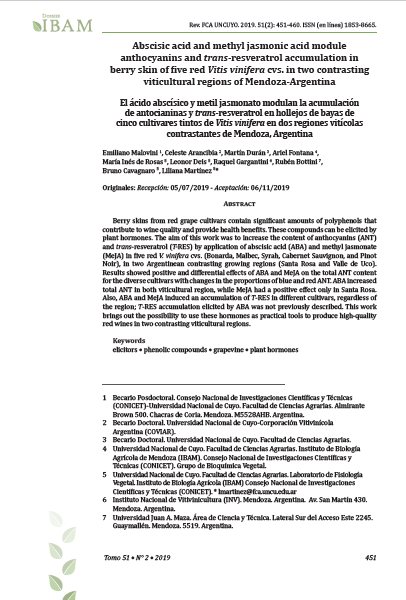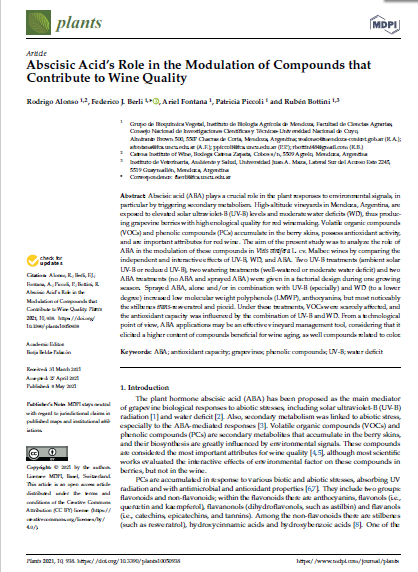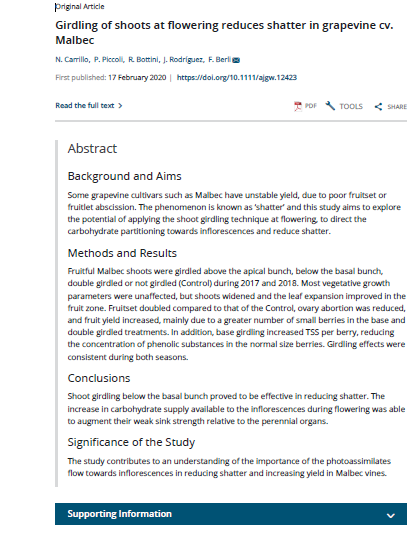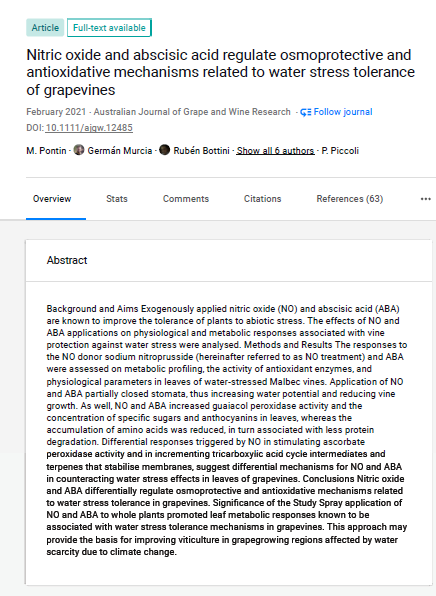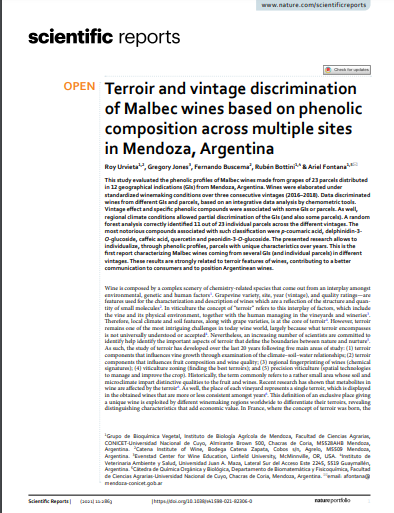Browsing Ciencias Ambientales, Agroindustrias y de la Tierra by Author "Bottini, Rubén"
Now showing items 1-5 of 5
-
Abscisic acid and methyl jasmonic acid module anthocyanins and trans-resveratrol accumulation in berry skin of five red Vitis vinifera cvs. in two contrasting viticultural regions of Mendoza-Argentina.
Malovini, Emiliano; Arancibia, Celeste; Durán, Martín; Fontana, Ariel; Deis, Leonor; Gargantini, Raquel; Bottini, Rubén; Cavagnaro, Bruno; Martínez, Liliana; De Rosas, María inés (Comité editor Revista de la Facultad de Cs. Agrarias, Universidad Nacional de Cuyo., 2019-11-06)Berry skins from red grape cultivars contain significant amounts of polyphenols that contribute to wine quality and provide health benefits. These compounds can be elicited by plant hormones. The aim of this work was to increase the content of anthocyanins (ANT) and trans-resveratrol (T-RES) by application of abscisic acid (ABA) and methyl jasmonate (MeJA) in five red V. vinifera cvs. (Bonarda, Malbec, Syrah, Cabernet Sauvignon, and Pinot Noir), in two Argentinean contrasting growing regions (Santa Rosa and Valle de Uco). Results showed positive and differential effects of ABA and MeJA on the ... -
Abscisic Acid’s Role in the Modulation of Compounds that Contribute to Wine Quality
Alonso, Rodrigo; Berli, Federico; Fontana, Ariel; Piccoli, Patricia; Bottini, Rubén (Comité Editorial Plants Journal, 2021-05-08)Abscisic acid (ABA) plays a crucial role in the plant responses to environmental signals, in particular by triggering secondary metabolism. High-altitude vineyards in Mendoza, Argentina, are exposed to elevated solar ultraviolet-B (UV-B) levels and moderate water deficits (WD), thus producing grapevine berries with high enological quality for red winemaking. Volatile organic compounds (VOCs) and phenolic compounds (PCs) accumulate in the berry skins, possess antioxidant activity, and are important attributes for red wine. The aim of the present study was to analyze the role of ABA in the ... -
Girdling of shoots at flowering reduces shatter in grapevine cv. Malbec.
Carrillo, Natalia; Piccoli, Patricia; Bottini, Rubén; Rodríguez, José; Berli, Federico (Comité editorial Australian Journal of Grape and Wine Research, 2020-02-17)Background and Aims Some grapevine cultivars such as Malbec have unstable yield, due to poor fruitset or fruitlet abscission. The phenomenon is known as ‘shatter’ and this study aims to explore the potential of applying the shoot girdling technique at flowering, to direct the carbohydrate partitioning towards inflorescences and reduce shatter. Methods and Results Fruitful Malbec shoots were girdled above the apical bunch, below the basal bunch, double girdled or not girdled (Control) during 2017 and 2018. Most vegetative growth parameters were unaffected, but shoots widened and the leaf ... -
Nitric oxide and abscisic acid regulate osmoprotective and antioxidative mechanisms related to water stress tolerance of grapevines
Pontin, Mariela; Murcia, Germán; Bottini, Rubén; Piccoli, Patricia; Fontana, Ariel; Bolcalto, Leonardo (Comité editorial Australian Journal of Grape and Wine Research, 2021-03-22)Exogenously applied nitric oxide (NO) and abscisic acid (ABA) are known to improve the tolerance of plants to abiotic stress. The effects of NO and ABA applications on physiological and metabolic responses associated with vine protection against water stress were analysed. -
Terroir and vintage discrimination of Malbec wines based on phenolic composition across multiple sites in Mendoza, Argentina
Urvieta, Roy; Jones, Gregory; Buscema, Fernando; Bottini, Rubén; Fontana, Ariel (Scientifics Reports Editorial, 2021-02-03)This study evaluated the phenolic profiles of Malbec wines made from grapes of 23 parcels distributed in 12 geographical indications (GIs) from Mendoza, Argentina. Wines were elaborated under standardized winemaking conditions over three consecutive vintages (2016–2018). Data discriminated wines from different GIs and parcels, based on an integrative data analysis by chemometric tools. Vintage effect and specific phenolic compounds were associated with some GIs or parcels. As well, regional climate conditions allowed partial discrimination of the GIs (and also some parcels). A random forest ...







